No New Coal without 100% CCS
Whitehall (Downing St), London. Thursday April 30, 2009
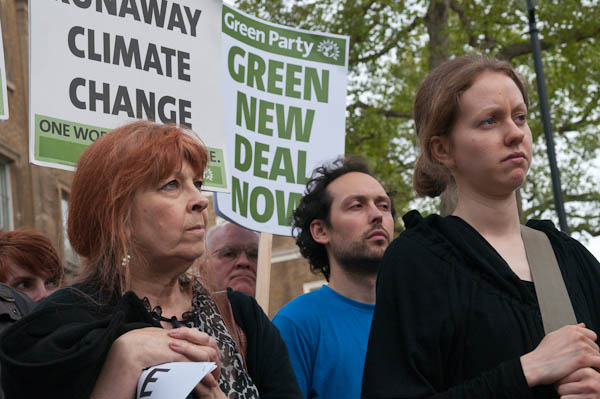
Campaigners opposite Downing St oppose slightly less dirty coal-fired power
stations
more pictures
Although the government's decision to ban new coal-fired power stations without
any carbon capture was welcomed by the Campaign against Climate Change, they
remain concerned about the huge levels of carbon emission still involved in
the proposals which still allow 75-80% of the carbon to be emitted.
Even if technology improves over the next 15 years to allow carbon capture
to be increased from the initial 20-25% to a full 100%, four large power stations
would still emit a massive 275 million tonnes of carbon dioxide, creating
a serious risk of catastophic climate change.
There is no certainty that 100% effective technology can be developed in
the next 15 years, and it is impossible to believe that if it is not available
these power stations would then be closed down. The current proposals would
lead other governments to begin similar massively polluting programs on what
are little more than vague promises of eventual reductions, truly a recipe
for disaster.
This small demonstration (publicity had been rather lacking) called for no
new coal to be built without 100% CCS. Among the speakers were Joss Garman
from Greenpeace and London Green Party MEP Jean Lambert.
more pictures
Café Jiro Opens
Flowers Gallery, Cork St, London. April 29.2009
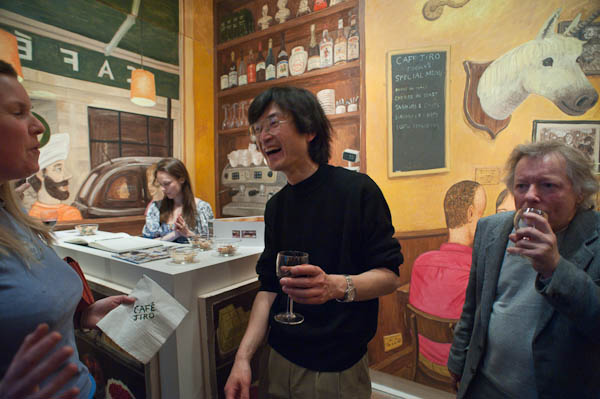 Jiro
Osuga in Café Jiro on Cork St - showing at Flowers until May 23, 2009
Jiro
Osuga in Café Jiro on Cork St - showing at Flowers until May 23, 2009
more pictures
Although it would be nice to have to have a decent café in the centre
of Mayfair, Jiro's Cafe will only be there until May 23, and the food, wine
and hand-painted serviettes were only for the opening night. But in place
of the usually rather arid interior of a West End art gallery Jiro
Osuga has created a marvelously decorated and coherent space, covering
the white walls with canvases to create a space where, when filled with the
opening night crowd it was sometimes hard to separate them from the figures
painted on the walls.
It is a world that includes many references both to friends and to the world
of art, and to the buildings fronting the street opposite the gallery, as
well as to a few of the famous - with Marx, Lenin and Chairman Mao sharing
a table in one corner - and doubtless many more I failed to recognise.
It's a fine piece of art and something that will appeal to all but the blind
or blinkered - even causing something of a stir among other Cork St gallerists,
and I hope will be shown elsewhere after it comes down in Mayfair.
Jiro and I were both involved for a dozen years or so in 'The
London Arts Café', set up by Mireille Galinou, which for 12 years
put on events and exhibitions related to art about cities. Mireille's original
hopes to open an physical art café never materialised, though one of
the shows I helped to organise (along with Jiro and others) was 'Café
Life' in 2005. and we published 20 issues of the magazine 'Art and Cities'.
LAC's successor is a 'Meetup group', also called Art
and Cities, open to all. On the shelves of Café Jiro you can see
the wine from Chateau Galinou, and Mireille's dog it tied to the sandwich
board at the entrance to the café.
more pictures
International Workers Memorial Day
Tower Hill to City Hall, London. April 28, 2009
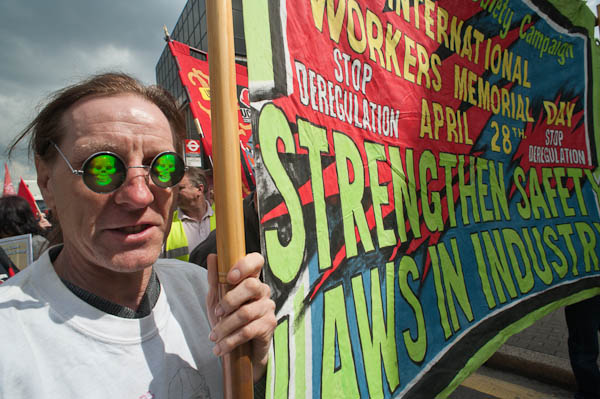
Carrying the Construction Safety Campaign banner at the head of the march
more pictures
International Workers Memorial Day, April 28, started in
Canada in 1984 and is marked in many countries around the world as a day when
workers "come together to remember the dead and fight for the living."
Talks are taking place with the UK government over official recognition of
the day, with UCATT calling for it to become a bank holiday.
Around 5000 people die in the UK each year directly from work-related causes,
with asbestos still the major killer. The construction industry is one of
the most dangerous, with over 2800 deaths in the last 25 years, including
72 in 2007/8. Falls, being hit by moving objects and electrocution are the
most common causes.
Accident rates are increased by the use of sub-contractors, and are higher
among smaller firms. Even in the few cases that result in successful prosecution,
the sentences imposed are often trivial fines.
The commemoration in London, organised by UCATT and the Construction
Safety Campaign was supported by other groups including the Communication
Workers Union, Unite, FACK (Families Against Corporate Killers) and the
Batter sea Crane Disaster Action Group.
The event started with a short rally and laying of wreaths at the UCATT statue
to the Unknown Construction Worker at Tower Hill. The march then
stopped briefly at Riverbank House, a Sir Robert McAlpine construction site,
where 30 year old Richard Chaddock from Newark, Notts, employed by a sub-contractor,
died on 19 March. After a short speech, hard hats were removed for a minute's
silence.
The march was met by trade unionists from the HSE on their tea-break outside
there office on Southwark Bridge Road. Speakers there pointed out that the
number of HSE inspectors has dropped by around 20% since 2004, and that the
number of prosecutions has dropped by around 40% in the same period, despite
accident rates remaining high.
Around a hundred marchers arrived at City Hall where they were met
by a socialist band and others who had come for the rally. The Mayor, Boris
Johnson, responsible for some of the largest construction contracts in the
UK, had been invited to attend but was unable to do so, and apparently also
unable to find a representative to make the journey down from the offices.
more pictures
World Day for Animals in Laboratories
Whitehall Place, London. April 25, 2009
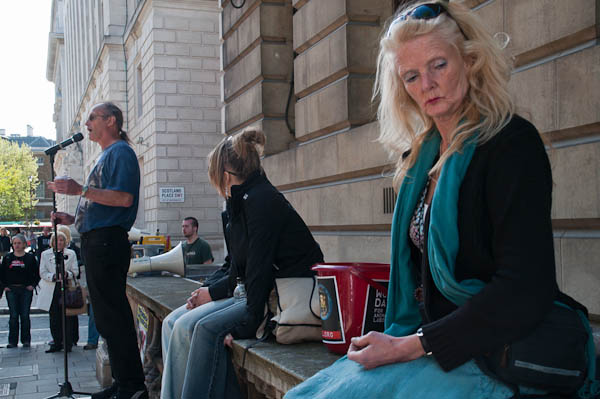 The
rally in Whitehall Place
The
rally in Whitehall Place
more pictures
April 24 is recognised world-wide as World Day for Laboratory Animals,
and a national march and rally was held in London on the following day. Unfortunately
I missed the march having spent rather longer than I'd intended with the Tamils
in Parliament Square and arrived part way through the rally, so there was
not a great deal to photograph.
more pictures
Tamil Hunger Strike Continues
Parliament Square, Westminster, London. April 25, 2009
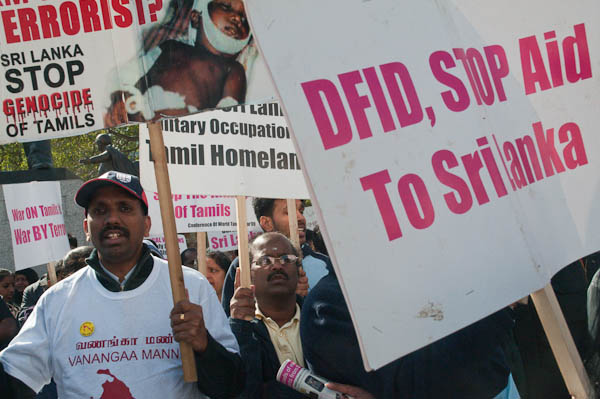 There were perhaps a thousand Tamils in Parliament
Square when I visited the demonstration again
There were perhaps a thousand Tamils in Parliament
Square when I visited the demonstration again
more pictures
The Tamil demonstration against the killing of their people in Sri Lanka
continues in Parliament Square. Hunger striker Subramanyam Parameswaran
is weak but in good spirits after 19 days there, determined to carry on until
the end. Each day a team of supporters also fast outside the makeshift tent
in which he lies, and many young Tamil men have pledged to carry on his hunger
protest if he dies. He has now announced his intention to stop taking water
shortly if the demands for an end to the attacks are not met.
Much though I sympathise with the Tamils and their resistance to the Sri
Lankan government attempts to marginalise them, it is hard to see much chance
of a resolution to the current conflict that will offer any future to them.
Military defeat of the LTTE as an army seems inevitable, along with the continuing
resettlement of many Tamils in camps under government control accompanied
by a new phase of guerilla combat.
more pictures
175 Years of Union Organising
Caledonian Park - Edward Square, Islington, London. April 25, 2009
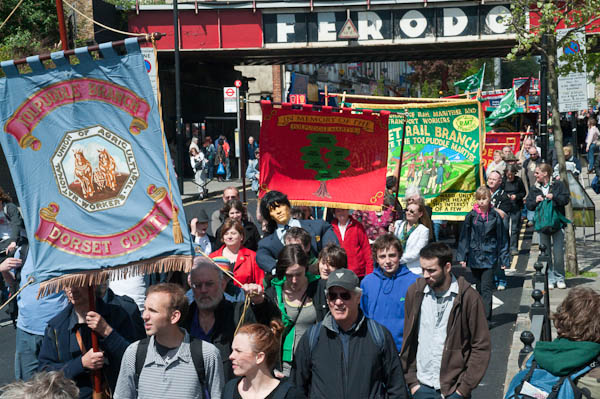 Union
banners commemorate the march organised to support the Tolpuddle Martyrs in
1834
Union
banners commemorate the march organised to support the Tolpuddle Martyrs in
1834
more pictures
I was glad that I went to the TUC march and rally to commemorate the Grand
Demonstration in support of the Tolpuddle Martyrs in 1834, which made its
way from the clock tower of the former Caledonian Market to the small park
that remains of Copenhagen Fields led by the brilliant brassy sounds of the
Cuba Solidarity Salsa Band. The day had started miserable and wet,
but we walked down Pentonville Road in bright sun, and as we danced past the
white painted buildings of the prison it could almost have been Cuba, and
the trade union banners spread out behind made an inspiring display.
We were in Caledonian Park to commemorate the 175th anniversary of the great
demonstration and to watch Frances O'Grady, TUC Deputy General Secretary,
unveil a plaque here, where around 100,000 met in the fields around Copenhagen
House at the start of the 'Grand Demonstration' organised by the
Metropolitan trade unions, carrying a petition with over 200,000 signatures
to Parliament demanding the release of the six Dorset farm labourers, led
by a Methodist lay preacher, who had formed the 'Friendly Society of Agricultural
Labourers' in 1832. Forming such a trade union (it became a part of the
Grand National Consolidated Trades Union (GNCTU)) had become legal when the
Combination Acts were repealed in 1824. The six men were convicted
not for trade union membership as such, but for having sworn an oath to each
other, which they had done in forming their friendly society, and were and
sentenced to transportation to Australia.
The 'Grand Demonstration' was I think the first mass demonstration
by trade unions and the start of a successful popular campaign that led eventually
to the mens' release - a pardon was granted in 1835 (but it was 1837 before
they arrived back in the UK.) The march was an important event in the early
history of trade unions, and, unlike more recent mass demonstrations - such
as the many over the invasion of Iraq - particularly the massive march in
Feb 2003 - it and the campaign was successful.
I don't have too much time for the cult that has grown up around six men
from Tolpuddle. What they did was probably little different from what many
others were doing, and what made them martyrs was the complaint on a fairly
obscure point of law by a local landowner that led to their trial and transportation.
What seems to me important is not these six but the solidarity and support
shown by hundreds of thousands if not millions of other people around the
country, something which remains at the centre of the trade union movement.
I was sorry not to stay on for the festival in Edward Square, close to a
mural painted in 1984 to celebrate the 150th anniversary of the Tolpuddle
Martyrs, leaving shortly after the event was opened by Mayor of Islington
Stefan Kasprzyk and Megan Dobney SERTUC Regional Secretary.
The festival there promised to be a rather more exciting event than that promoted
as a late St George's Day event by Boris Johnson in Trafalgar Square.
Although that also had some big names in folk on the bill, when I drifted
through it a couple of times later in the afternoon it seemed very much lacking
in atmosphere, and the performances I glimpsed on the giant screen didn't
prompt me to stay. Boris has a lot to learn in organising such events and
getting people involved.
more pictures
St George & the Dragon, Trafalgar Square
Trafalgar Square, London. April 23, 2009
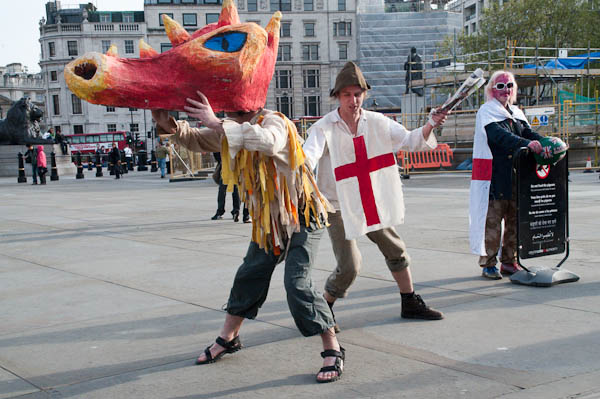
St George slays the dragon with his newspaper sword
more pictures
I'd noticed what looked like a troop of actors, standing around by the cafe
at the back of the square, looking at the noisy group on the plinth. It turned
out that the Suffolk Howlers had been performing in front of the
Tintoretto Saint George and the Dragon in the National Gallery and
having seen the youths giving their performance of English yobbiness to an
audience of tourists sitting on the steps at the back of the square had decided
to give them a performance of a rather different concept of Englishness, their
version of the traditional 'St George & The Dragon'.
This had a little more complex plot than the version I'd seen earlier in
Southwark, including Beelzebub, a doctor and a Turkish knight, with additional
contributions from a couple of bystanders, one who had been imbibing from
a bottle labelled Lucozade that appeared to have rather more intoxicating
properties than usual, and the other the displaced street performer. While
he largely draped himself over the "Please do not feed the pigeons banner',
Lucozade man took a far more active role in the proceedings, giving first
aid to the injured St George and executing some surprisingly nimble dance
steps and generally adding a chaotic improvisation to the performance. He
really deserved the applause when he took a bow with the rest of the cast
at the end of the play.
more pictures
England Supporters in Trafalgar Square
Trafalgar Square, London. April 23, 2009
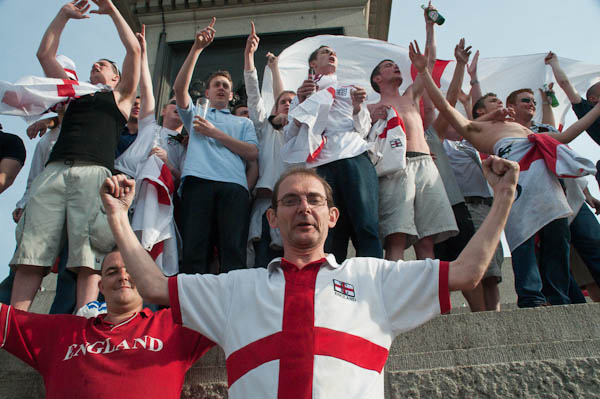
A rowdy group of football supporters on the plinth of Nelson's Column
more pictures
About 25 football supporters, many in England shirts were having a noisy
time with Nelson, and like him the Heritage Wardens and police seemed to be
turning a blind eye. Everyone seemed fairly good-natured, someone rode around
on a bike doing wheelies and a football was occasionally blasted at the group,
though perhaps thanks to those bottles of Becks it often went wide or over
into the traffic.
With them was one of the regular street performers from the square who had
given up trying to attract a crowd against this opposition. After I'd been
there a few minutes he started getting some of the lads to decorate their
faces with greasepaint.
more pictures
The George Inn, Southwark
George Inn, Borough High St, Southwark, London. April 23, 2009
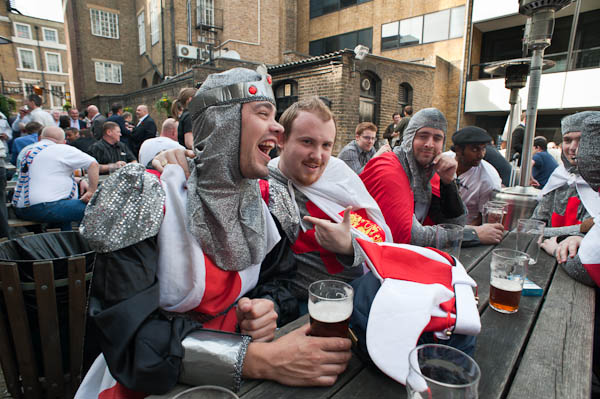
In the courtyard of the George Inn
The George Inn seemed the obvious place to go on St George's Day, and obviously
everyone thought so, as it was fairly crowded. But I was there too late to
catch many of the people who had been in a procession earlier still dressed
up - you can see a couple more pictures from there - and one of a woman in
the audience at Southwark Cathedral at the bottom of the last page on The
Lions part:
the last page
The Lions part: St George & the Dragon
Red Cross Garden & Southwark Cathedral, London. April 23, 2009
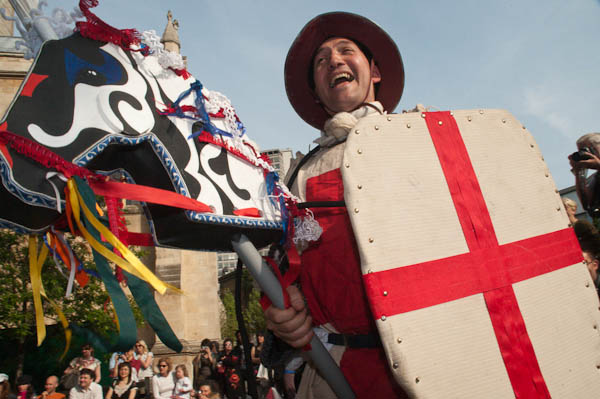 St
George gallops across Southwark Cathedral Churchyard on his horse
St
George gallops across Southwark Cathedral Churchyard on his horse
more pictures
Our national day was being celebrated rather more actively across the river
in Southwark, and one of the livelier events was a series of performances
of 'The Ballad of St George & the Dragon' by The Lions part,
a group of performers associated with the Globe Theatre on Bankside.
Red Cross Garden, along with the adjoining hall and cottages, was established
by the social reformer Octavia Hill in 1897-90 and made a pleasant venue for
this short musical variation of the traditional story. I arrived a little
after it started, but fortunately after a short interval they gave a second
performance. Many of the audience were children from the nearby cathedral
school, and they clearly enjoyed it.
After the performance I walked with the players as they made their way through
Borough Market to Southwark Cathedral to give another performance in the churchyard
there.
more pictures
St George's Day - Trafalgar Square
Trafalgar Square, London. 23 April, 2009
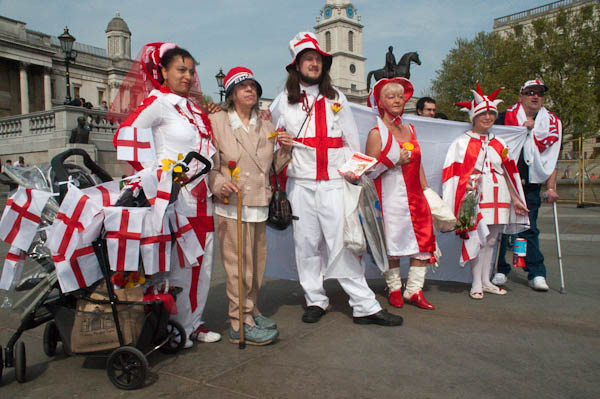
A few people were suitably dressed for the occasion
more pictures
Although there have been growing demands over the past few years for a proper
celebration of the English Patron Saint's day, there is still relatively little
happening on the day itself. I'd read there were going to be people in Trafalgar
Square, but when I arrived shortly after lunch there were very few people
around.
There were a few people from 'The English Democrats', a political
group which campaigns for an English Parliament and for St George's Day to
be made an English national holiday. An important aspect of their campaign
is to reclaim ideas of Englishness and the flag of St George from racist groups
including the BNP. Some of them were joined for the picture above by two women
making a charity collection for 'Save the Children'. The picture
reflects the inclusive nature of the English Democrats, with a Spanish and
and Irish woman included in the six people in the line.
Last year, some of those present had tried to visit the National Gallery
(in the background at left) and had been refused entry because they were wearing
our national flag of St George. I went with them when they tried again this
year and they were allowed in but were told they could not campaign or collect
money in the gallery.
As well as those I photographed there were a few more who wandered into the
square wearing shirts, hats or badges or wearing red roses who were obviously
expecting something to be happening and were disappointed. There were not
even any St George's flags visible on any of the buildings around the square.
There is going to be some sort of event on Saturday, but it does seem a little
odd that there is so little sign on the day itself.
more pictures
Datchet
19 April 2009
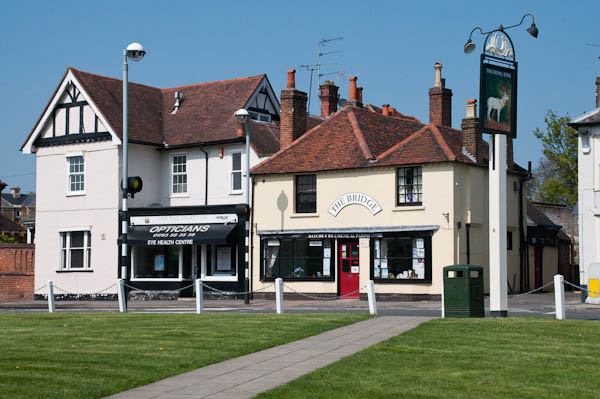
I'd cycled to Slough to photograph the Vaisakhi celebrations and on the way
home rested a little and took a few photographs in Datchet.
more pictures
Vaisakhi in Slough
Slough, Berkshire. Sunday 19 April, 2009
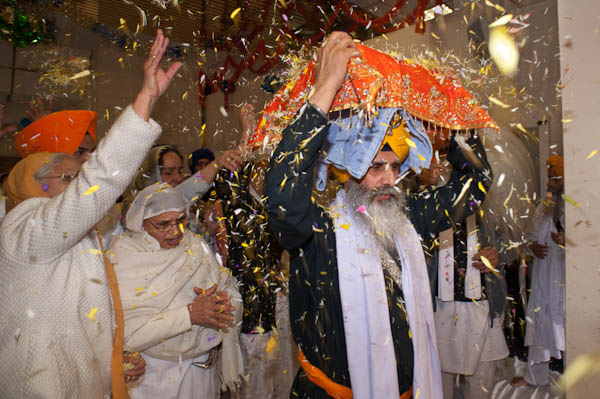
Flower petals fill the air as the Guru Granth Sahib is carried out to take
part in the Vaisakhi procession
more pictures
The Vaisakhi procession is a big event in Slough, and attracts large numbers
of people both to participate and to watch it making its way around the north
of the town. An ancient Indian festival marking the New Year, particularly
in the Punjab, it first became a special day for Sikhs when the third Guru
made it an annual national cultural gathering for Sikhs in 1567. But it gained
in significance in 1699, when the tenth Guru founded the Khalsa by baptising
five brave Sikh men who had proved themselves willing to give their lives
for their religion.
That the original five, the Panj Piyare, came from different castes
demonstrated the foundation of the Khalsa on social equality, and baptised
Sikhs all took the names Singh (Lion) for men and Kaur (Princess) for women
to show their equality. The tenth Guru was himself baptised by the five he
had baptised, changing his name also, to Gobind Singh. He proclaimed the Sikh
scriptures his eternal successor as the Guru Granth Sahib, so that
no living person would henceforth have a superior status as Guru. Sikh congregations
are democratic organisations that appoint Panj Piyare to take necessary decisions.
Sikhs believe that people of all faiths have the same human rights and should
be treated with equal dignity and respect, and Vaisakhi is a celebration of
this belief in equality and social justice. The procession includes the Panj
Piyare and the Guru Granth Sahib, carried on a throne and treated as always
with deep respect. There are also drummers and displays of martial arts, recognising
that it is necessary to fight against tyranny when all other means fail. There
were also a number of reminders of the many Sikh martyrs, and particularly
the 1984 massacre of thousands of Sikhs following the assassination of Indira
Ghandhi and the demands for an independent Sikh state of Khalistan.
Sikhs are very hospitable and generous, and I was made welcome in the Gurdwara
Sri Guru Singh Sabha and during the procession, and food and drinks were pressed
on me. Although I very much enjoy the vegetarian food, the sweets, the tea
and some other drinks are too sweet for my taste. The charity Diabetes UK
(and I'm a sufferer) was giving out information packs on the route - the Sikh
diet leads to cholesterol levels, coronary heart disease and diabetes above
the UK average.
Although the same basic features are found in all Sikh temples and in the
Vaisakhi celebrations, each Gurdwara has its own variations. You can see some
differences if you compare these pictures with those I took in Hounslow
a fortnight earlier.
more pictures
Loyal Orange Lodge Parade
Westminster, London. Saturday 18 April, 2009
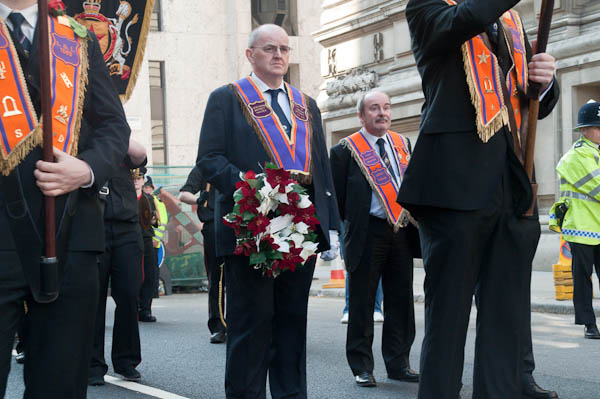
The march forms up in Tothill St
more pictures
The Metropolitan Provincial Grand Lodge is the Orange Order in Southern England
and a part of a "
world-wide brotherhood committed to upholding the
Protestant faith and the principle of civil and religious liberties for all"
and clearly states it will not accept anyone with racist views or who do not
support this principle.
It takes its name from William, Prince of Orange who landed in Devon
in 1688 to restore parliamentary democracy and prevent the imposition of the
Catholic religion by James II. This was the 'Glorious Revolution'
which forced James II to flee and made William king as William III. It was
a largely bloodless event, with few battles but some anti-Catholic riots,
and was the real beginning of parliamentary democracy here. Although it led
to greater freedom for dissenting nonconformist Protestants, it also passed
various anti-Catholic measures, denying them the right to vote, be MPs, hold
army commissions or marry the monarch - only the last of which is still in
force.
Although Orangemen insist on religious liberties for all, they remain dedicated
to keeping the Protestant faith free from any Catholic doctrines and practices,
as well as to its serious and dedicated observance throughout their daily
life and in religious attendance.
Saturday's London District LOL No. 63 Parade and Rally in central
London laid wreaths at the Cenotaph in Whitehall (where I left them to return
home) and at the statue of "King Billy" in St James's Square. Made
by John Bacon, this bronze was put here in the square in 1808 and shows William
III as a Roman general as his is horse about to trip over the mole-hill which
led to his death shortly after in March 1702. The "gentleman in black"
became the toast of many supporters of the Stuarts.
more pictures
Dutch Stereotypes
Trafalgar Square, London. Saturday 18 April, 2009
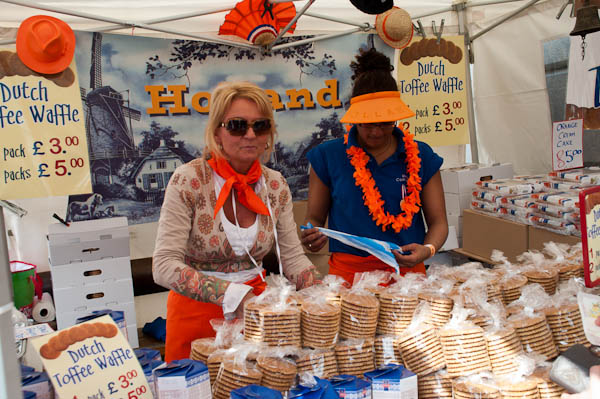 Dutch toffee waffles were on sale
Dutch toffee waffles were on sale
more pictures
In Trafalgar Square, the Dutch were holding a festival to prove their lack
of understanding of popular music and to sell cheese, chips and beer. The
cheese did look quite attractive. The only thing missing seemed to be a windmill,
but I probably just didn't look hard enough.
more pictures
Tamil Hunger strike Continues
Parliament Square, London. Saturday 18 April, 2009
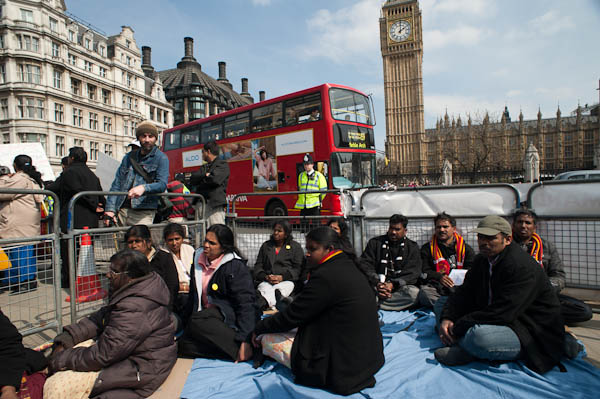
Tamils fast for 24 hour shifts in front of hunger striker Subramanyam Parameswaran
more pictures
The Tamil hunger strike continues in Parliament Square, though Subramanyam
Parameswaran, looked in poor condition and lay without moving under a quilt
while I was there. In front of him were a dozen or so people fasting for a
day at a time with him, a different group taking their place each day, while
around another 500 or so were chanting slogans to one side, calling for an
immediate and permanent ceasefire in Sri Lanka, with full access for the UN,
the Red Cross and other agencies, as well as the international press, along
with an opportunity for the Tamils in Sri Lanka to have a free and independently
observed referendum on their future.
The demonstrators expressed their whole-hearted support of the LTTE (Tamil
Tigers) and an independent homeland, Tamil Eelam.
more pictures
Shakespeare's Birthday - Coincidence
Cornhill, London. Saturday 18 April, 2009
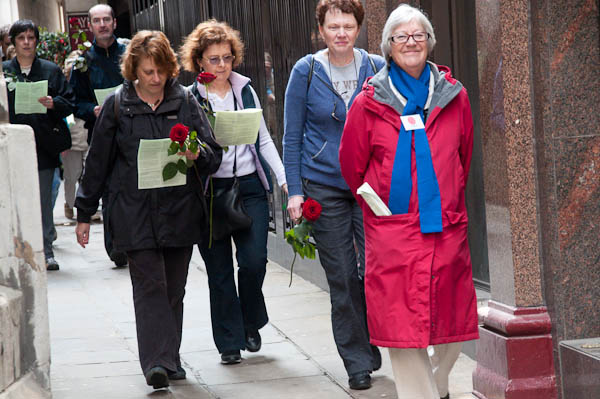
A group bearing roses comes up St Michael's Alley
more pictures
Standing close to the actual place where Ian Tomlinson died, I was surprised
to see a group of around 20 people, each holding a red flower coming towards
me, led by a woman with a badge saying 'Steward.' I photographed them as they
walked past and crossed Cornhill to the Starbucks opposite, where there were
a few flowers and a picture on the window of a young woman, along with a couple
of handwritten pages.
As I watched them, a young man gave a moving performance about her death,
which had a vaguely familiar sound to it, though I still failed to make the
connection. When the walkers had gone down the alley I asked him about it
and found that this was one of around 20 groups each being taken on a guided
walk around the city to various sites with similar performances to this of
one of the sonnets to celebrate Shakespeare's birthday next Thursday.
The spot where the performance took place was exactly where Ian Tomlinson
collapsed outside Starbucks after several assaults by police had led to his
internal bleeding. They alley that they are walking up in the picture above
is where he was finally treated by police medics and died. I doubt it it was
mentioned in the sheets they were carrying or if any of them even knew.
more pictures
Protest Against London Police
City of London Police HQ, Wood St, London, Sat April 18, 2009

Black eye and cuts at demonstration against police violence
more pictures
Around 50 demonstrators and almost as many of the press gathered outside
the Wood St HQ of the City of London Police on Saturday morning to
protest at the policing of demonstrations, particularly on April 1 in the
City of London. Speakers told of their experiences, being prevented from leaving
the area, pushed around and hit by police while protesting peacefully. As
well as posters and placards, the 'Four Horsemen' which lead the separate
marches to what protesters had intended to be a carnival protest were on the
pavement outside the police station.
While the vast majority of protesters on April 1 were peaceful, police chiefs
and politicians had spent the previous week ramping up the temperature and
predicting violence. Many of the police, particularly the TSG, came along
to the event psyched up and spoiling for a fight - whether or not they were
met with violence. Complaints were voiced about the failure of some officers
to wear their ID number and their refusal to give their number when asked.
The TSG in particular came in for criticism, being seen by many as simply
a trained group of thugs, with far too many officers who clearly enjoyed beating
people up.
Rather than concentrate on the small and readily identifiable minority of
protesters who came prepared to cause mayhem, the police attitude serves to
radicalise and provoke others to violent action. It was surprising that so
few of those there did allow themselves to be provoked, and the videos taken
of the police attacks on crowds show most of those being attacked simply holding
up their arms to protect themselves as police assault them with batons and
riot shields used as weapons, people standing there and chanting "We
are not a riot" and "Shame, shame, shame on you."
Today the demonstrators called for the police to remember that they are there
to serve the public not to control people by violent means, for an end to
the wholesale "kettling" of demonstrations, for the disbandment
of the TSG, and for proper training of the police in relating to demonstrations,
with the enforcement of proper discipline and regulations by senior officers
who should enforce an end to other officers turning a blind eye when police
behave illegally.
The death of Ian Tomlinson, though a tragedy, was only a symptom
of a much greater failure by the police in the proper conduct of their duties.
At the end of the protest I walked along to the memorial to him set up where
he was assaulted by police a minute or two before his death - and where police
failed to give him the medical attention that some of the demonstrators clearly
thought he then required. By the time they did take his injuries seriously
and attempt treatment a few yards down Cornhill it was clearly too late.
more pictures
Stop Police Brutality
New Scotland Yard, Westminster, London. Thursday April 16, 2009
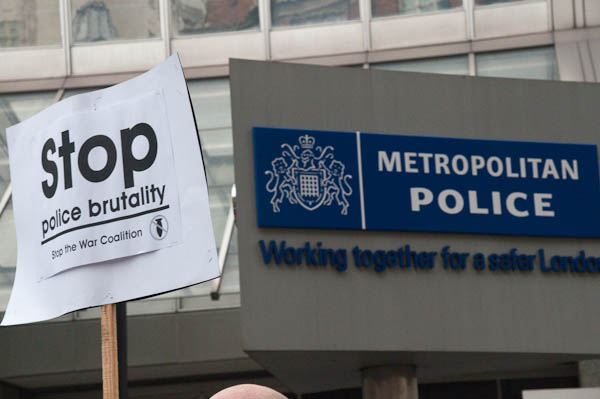
'Stop Police Brutality' 'Protest is not a crime' Are the Met working for a
safer London at demonstrations?
more pictures
Demonstrations continue as more and more allegations about police violence
against demonstrators emerge in the mainstream press. Many of the videos,
images and allegations began to appear immediately in blogs and web sites
and following further revelations about the tragic death of Ian Tomlinson
have finally begun to make their way into the mainstream media.
But there is certainly more to come. This was a demonstration with roughly
50 protesters and about the same number of media people, including several
photographers who were assaulted and injured during the protest - because
at times the police specifically targeted photographers. A number of cases
are expected to be taken to the courts which have yet to be mentioned in the
papers.
They also tried to remove photographers from an area at Bank, with an officer
beginning to address them as "Ladies and Gentlemen of the press"
and telling them that either they moved or they would be arrested. Later the
police had to back down over this illegitimate attempted use of the Public
Order Act - and they then denied they had actually been talking specifically
to the press - but the video now on the Guardian site is crystal clear.
At the Climate Camp they waited until the mainstream media had gone home
before wading in and assaulting peaceful demonstrators.
Among the speakers was MP Jeremy Corbyn who has begun to ask questions about
the incidents in Parliament, which returns from its recess on Monday.
Given it was not in session it was perhaps surprising that one of the reasons
given by police for asking that the protest move from the wide, empty pavement
outside Scotland Yard where there was plenty of room for it to the opposite
side of the road which has a very narrow pavement was that its presence might
impede the passage of MPs on their way to parliament. The centre of the road
is apparently the boundary of the zone defined in SOCPA, and since this demonstration
had not applied for permission it was illegal - whereas on the other side
it would have been lawful.
The request to move was put to to a show of hands by the demonstrators. Unsurprisingly
no one appeared to be in favour, and the "illegal" protest
continued.
more pictures
Tamils March - Stop Sri-Lanka Genocide
Temple to Hyde Park, London. Sat 11 April, 2009
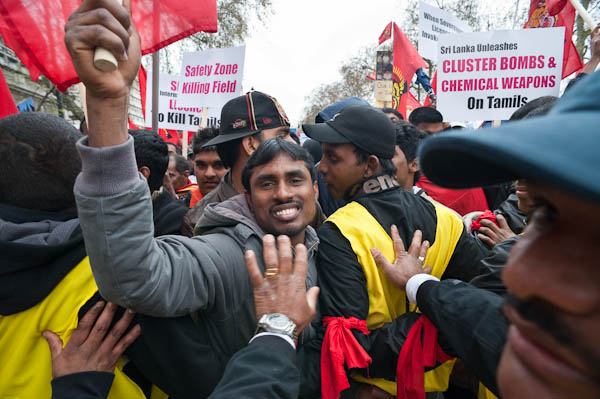
Stewards hold back enthusiastic Tamil demonstrators
more pictures
When even the police give an estimate of numbers as 100,000 you can be sure
it is a very big march, and as the crowds were generally pretty solidly packed
there seems little reason to question the independent estimates of around
150-200,000 people.
The great majority of them were Tamils, with only a few hundred white faces.
There didn't seem to be a great deal of media interest, and I saw no photographers
from major newspapers or news agencies and no cameras from major UK TV stations.
It was such a large event that I could have missed them, but usually there
is a crowd of media at the front of such marches as they start, while on Saturday
there was me and three other photographers, none of whom get regular work
for the mass media. However it was reported by some of them, including the
BBC where three very
short paragraphs and an indifferent photo accompany a longer piece on the
two Tamil hunger
strikers in Parliament Square. That event does seem to have attracted
considerably more media interest.
The march was also very much a family event - at one time I found myself
facing a row of around 20 push chairs, and they were many children carrying
placards and being carried on shoulders, as well as crowds of young people
and students, as well as adults of all ages, including some who looked old
enough to be my mother or father.
Marchers were united of course in their opposition to the killing of Tamils
in Sri Lanka, but also the vast majority of them in some way expressed support
for the LTTE, the
Liberation Tigers of Tamil Eelam. A few carried actual
tigers, fortunately only large toys, but many more wore the colours or carried
flags or portraits of the founder and leader of the Tamil Tigers,
Velupillai
Pirapaharan (sometimes spelt Prabhakaran.)
In the UK, the LTTE has been a proscribed organisation under the Terrorism
Act 2000 since 2000. This makes it a terrorist offence for a person to
support the group or wear clothing which arouses the "reasonable
suspicion that he is a member or supporter of a proscribed organisation."
Police sensibly made no attempt to arrest the 200,000 marchers on Saturday
despite their clear breach of the law.
Although enthusiastic, the Tamils had no intention of causing serious trouble
in London and only three arrests were reported. I saw only one small incident,
where police prevented marchers from carrying a dummy with a photograph which
of Sri Lanka's President Mahinda Rajapaksa as its face. Once this
photograph was removed they allowed them to continue.
It takes only a few seconds to use this
form to send an e-mail letter to the UN High Commissioner for Human
Rights about the Tamil crisis and there is also a petition form which
can be downloaded on the Tamil Writers
Guild for filling in and faxing to your MP or Gordon Brown.
more pictures
March in Memory of Ian Tomlinson
Bethnal Green Police Station & Bank. Sat 11 April, 2009
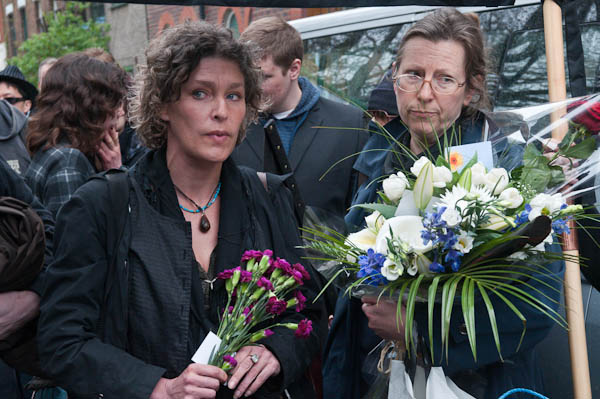
Marchers with flowers to remember Ian Tomlinson (Marina Pepper at left)
more pictures
Several hundred marchers, some carrying flowers, and almost as many photographers
and videographers turned up at Bethnal Green Police Station for the start
of a memorial march for newspaper seller Ian Tomlinson. The march
was called by G20 Meltdown, and Professor Chris Knight and
Marina Pepper were among those who led the march. They had planned
a carnival party of protest at the Bank of England on April 1, but police
turned it into something far more sinister, which ended with many demonstrators
being assaulted by police and Tomlinson's death.
At the Tomlinson family's request, the march was peaceful, silent and respectful.
Although the family did not take part in the march, stepson Paul King spoke
briefly at the start from the steps of the police station, surrounded by a
five-deep semicircle of cameras. He described the family's trauma from the
tragic death of his step-father, a "much-loved and warm-hearted man,"
and pain at seeing the video of the assault, and hoped that the investigation
would be full and that "action will be taken against any police officer
who contributed to Ian's death through his conduct." Short speeches
from the organisers called for a fully independent enquiry into police violence
surrounding the G20 protests and for criminal charges to be brought against
those responsible.
Leaflets were distributed for a new campaign to end violent police tactics
at peaceful demonstrations. There is a No
to Police Violence web-site and also a blog, Once
Upon A Time in Hackney. Today the police were solicitous, on their best
behaviour, clearly wanting to avoid any friction; the officer in charge was
one of those who had been in charge at Bank on the day the incident happened.
Some marchers carried flowers to lay close to where Ian Tomlinson was the
victim of an unprovoked attack from behind on the corner of Royal Exchange
Buildings. Here there were more speeches, which I missed, having left to photograph
the Tamil march. Among those marching were some of Sean Rigg's family, and
his sister was one of the speakers at Bank, talking about his death in police
custody after being taken ill at Brixton Police Station on Thursday 21 August
2008. His family also took part in last year's annual United
Friends and Families march along Whitehall in October and the Justice
4 Ricky Bishop march in south London in November.
Chris Knight had announced he would be making a vigil at Royal Exchange Buildings
in memory of Ian Tomlinson over the Easter weekend, and invited people to
come at any time, but in particular to join a candlelit vigil at 8pm. I couldn't
make that but I did call in the afternoon and photograph him and the flowers
at the scene.
more pictures
Tamils on Hunger Strike
Parliament Square, London. Friday 10 April, 2009
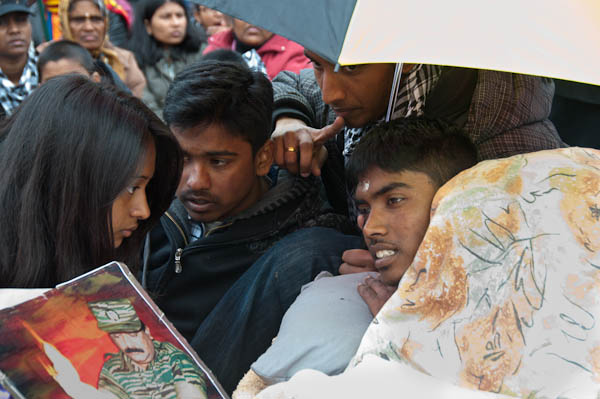
One of the two young men on hunger strike is supported by
his friends
more pictures
Tamils staged an unofficial protest on Westminster Bridge last Monday evening,
closing it and making headlines. Some have remained in Parliament Square since
then, supporting two men on a hunger strike. The men, both in their twenties,
are students in south London.
There have been repeated allegations of police misconduct and attacks on
the Tamils during their continuing demonstration, but although there was a
very strong police presence they were simply standing around and watching
while I was there. The protest is unlawful as permission required under SOCPA
was not sought.
There were two hunger strikers, both of whom looked to be suffering from
their ordeal without any food or fluids since early on Tuesday morning, and
medical advice was that their condition was now critical. Earlier in the morning
both had agreed to accept water for the first time. One of them suspended
his hunger strike on the day after I took these pictures to speak at the rally
and to travel to talks at the UN in New York together with MPs Simon Hughes
and Des Browne, but will return to continue the hunger strike unless the genocide
in Sri Lanka is stopped.
more pictures
Good Friday
Waterloo Station & Victoria St, London. Friday 10 April, 2009
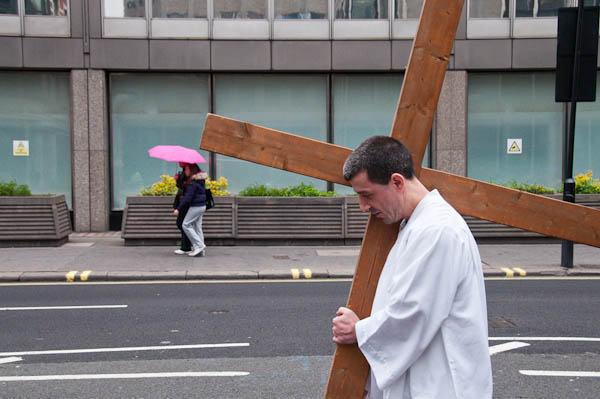
Carrying a cross along Victoria Street
more pictures
Christians celebrate Good Friday and the crucifixion of Christ with public
events in different areas of London (and of course elsewhere.) This year I
stopped briefly at the public service on the concourse at Waterloo Station
to take pictures and sing a couple of hymns with the congregations from North
Lambeth who had previously held a procession of witness around the area.
One of the larger Good Friday events in London is the annual 'Crucifixion
on Victoria Street' in Westminster which links three large and imposing
churches. Methodist Central Hall is a vast neoclassical building from the
early 20th century and on its side has a plaque reminding us that it was here
that the United Nations were inaugurated, with the first meeting of the UN
General Assembly here in 1946.
After a short service facing here, the procession formed up and made its
way down Victoria St to Westminster Cathedral for more hymns, readings and
prayers on the steps there. In his short address, Cardinal Cormac Murphy
O'Connor was visibly moved as he reminded us all that this would be the
last time he would appear during this occasion.
The procession then returned along Victoria St for a further service in Westminster
Abbey, where I left it to come home.
more pictures
Ponders End to Tottenham Hale
Lea Navigation, London. Thursday 9 April, 2009
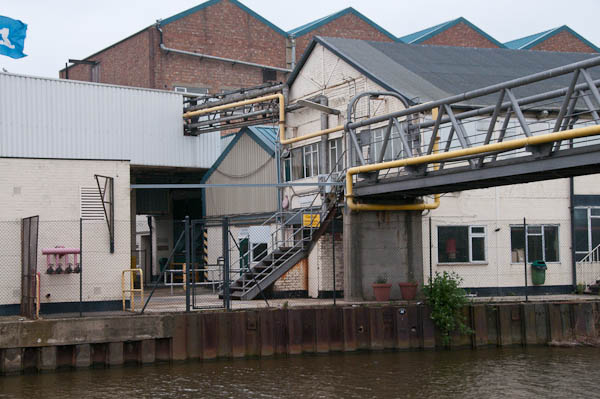
Visteon (Ford) works from across the canal at Ponders End
more pictures
After leaving Visteon's Morson Rd factory, I took the opportunity for a walk
by the Lea Navigation, first going to look at one of the many areas I'd photographed
in the 1980s (and at various times since) just to the north, then returning
south past the back of the factory and on for the several miles to Tottenham
Hale.
Despite the overcast sky with occasional light rain it was a pleasant way
to fill the time before I was due to meet with friends at a Fleet Street pub
later in the afternoon and to record some of the changes in the area. In recent
years - along with many other photographers - I've concentrated more on the
lower Lea and the area immediately around the Olympic site, but this area
also offers considerable scope for regeneration. Many of its former industrial
sites have fallen out of use, and some area already re-developed.
more pictures
Visteon Occupation Ends, Fight Continues
Ponders End, Enfield, London. Thursday 9 April, 2009
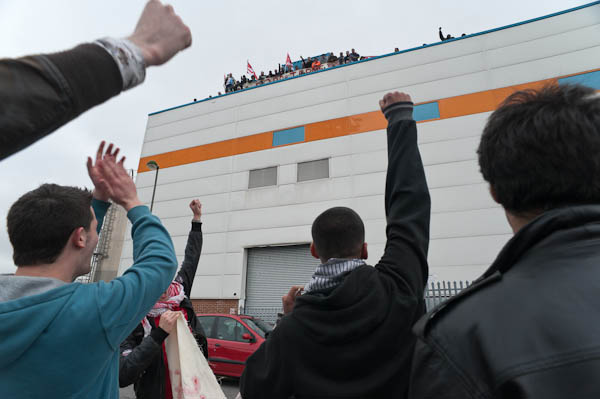
Students raise fists in support of Visteon workers shortly before the end
of the occupation
more pictures
Emotions ran high as the workers occupying the Visteon factory in
Enfield came out in compliance with the court order at mid-day on Friday.
They were embraced by Unite convener, Kevin Nolan and others
and cheered by a crowd of several hundred who had come to give support. Robert
Benham emerged holding his 35-year long service award, received last September
- for most of which time he was employed directly by The Ford Motor Company
before they devolved their activities at Enfield to Visteon which was set
up as a part of Ford. After all the workers had come out, Nolan was carried
along the street on the shoulders of two men.
The occupiers thanked the many students, trade unionists and others who had
supported them throughout, and announced their plans to keep up the fight
by continuous picketing of the two factory gates in an attempt to prevent
administrators KPMG from gutting the factory and selling its high-tech machinery
to China.
Unite has given full support to the Visteon workers, and joint general secretary
Derek Simpson met with Ford's European Chairman and also flew to America with
Nolan and others for meetings with Visteon senior management earlier in the
week. Further meetings with Visteon are expected next week in an undisclosed
location, and there are hopes of progress then to reaching a satisfactory
agreement. The workers are demanding the terms that they were promised by
Ford when Visteon was established.
more pictures
Vaisakhi in Hounslow
Sri Guru Singh Sabha, Alice Way, Hounslow. Sunday 5 April
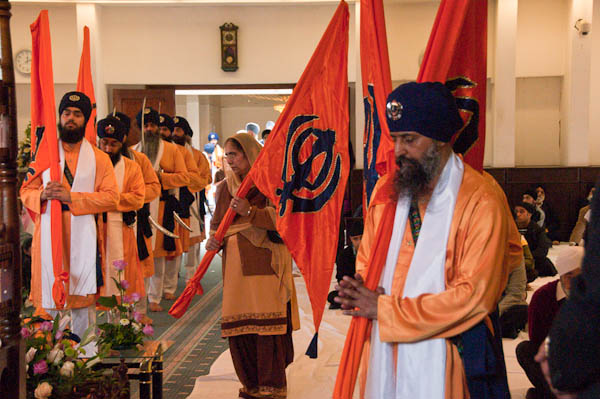
The Sikh flag bearers and the Panj Pyare in the worship hall before the procession
more pictures
One of the great things about photographing Vaisakhi is the welcome and co-operation
that you get from everyone at the Gurdwara. I have a great respect for the
Sikhs and Sikhism, which embodies principles that we can all strive for, whatever
our religion, or living honestly, treating people equally and fairly, serving
others and being generous to those less fortunate.
Vaisakhi celebrates the day in 1699 when the 10th Sikh Guru initiated five
faithful Sikhs to become the first Khalsa or Pure. These original Khalsa are
represented in the event by the Five Beloved Ones (Panj Pyare) in
saffron robes carrying ceremonial swords.
The 10th Guru also appointed the teaching in the Sikh scriptures, the Guru
Granth Sahib, as the eternal spiritual guide (Guru) for Sikhs, and it occupies
a position of great respect both during the ceremonies in the worship hall
and on a throne in the decorated lorry which travels behind the Panj Pyare
in the procession.
Although the basics have been the same at the five Gurdwara at which I've
photographed Vaisakhi, there are significant differences between them. Perhaps
most obvious the two times I've been to Hounslow is the important place in
the procession and the stewarding taken by young women.
My thanks to the Sikh photographer who suggested I follow him and thus not
miss significant parts of the ceremonies.
more pictures
Primark - Fashion on the Cheap from Sweatshops
Oxford St, London. Saturday 4 April, 2009
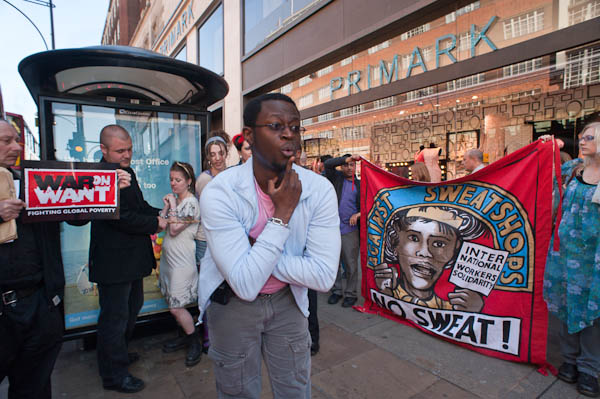
War on Want and No Sweat hold a fashion show outside Primark Oxford St with
models in chains
more pictures
I've never seen myself as a fashion photographer, but today I photographed
a fashion show. But this was no ordinary fashion show, and the catwalk was
on the pavement, outside Primark's flagship Oxford Street store. War on
Want and No Sweat were drawing attention to Primark
profiting by selling clothes made by sweated labour in Bangladesh.
The models were in chains to symbolise the slave labour conditions of the
Bangladeshi workers who make the cut-price fashions on sale at Primark. Workers
who make the clothes earn as little as 7p an hour and work up to 80 hours
a week.
Primark opened the Oxford St store two years ago, and are one of the few
businesses to have flourished in the recession as people turn to cheaper suppliers
- their profits in the year to last September were up by 17% at £233
million.
Primark have a notice in their window saying they care about the conditions
of the workers who make their clothes, but the reports by War on Want tells
a very different story. These clothes are only cheap because those who make
them get poverty pay, work long hours and get sacked if they try to organise
or ask for improvements in their dangerous and unhealthy working conditions.
No Sweat's Primark campaign is in solidarity with the Bangladeshi National
Garment Workers Federation. You can find more facts on the No
Sweat web site,
and the War
on Want web site where you can also download their updated report, Fashion
Victims II.
Two years since their first Fashion Victims report, despite the
protestations of Primark that they ensure their clothes area produced fairly,
this new report "shows workers making clothes for Primark, Tesco
and Asda are still being exploited, despite promises from companies to improve
the lives of their workers. In fact, given the damaging effects of the global
food crisis, workers are now in an even worse position than they were before."
According to Paul Collins of War on Want "Gordon Brown's claim that
the G20 summit deal will tackle global poverty ignores the reality that UK
companies such as Primark are trapping people overseas in dire hardship. Unless
he regulates British firms, growing numbers of the poor will pay a terrible
price for the world economic crisis."
The fashion show attracted the attention of passers-by, who took leaflets
about the shocking conditions that are behind the high profits in selling
cheap clothes. It need not be so. Primark and others could still have a moral
and reasonably profitable business if they restrained their greed and ensured
that the workers who make their clothes worked in reasonable conditions and
got a living wage - which in Bangladesh is only around £45 a month.
But that is over three times what workers making clothes for Primark are currently
paid.
more pictures
City Walk
Bank and Bishopsgate. Saturday 4 April, 2009
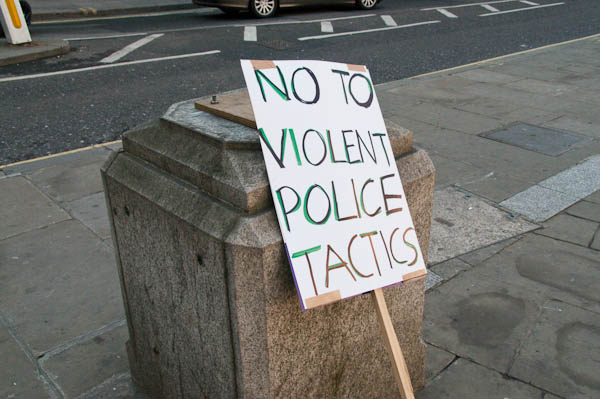
At Bank - 'No to Violent Police Tactics'
more pictures
I got back from Enfield too late to photograph one of the several marches
in memory of the newsvendor Ian Tomlinson who died of a heart attack minutes
after being attacked and violently pushed to the ground in an unprovoked attack
by a riot policeman (Guardian
video), although I could see and hear the police helicopter following
the small group on its way to Bethnal Green. The video also shows him clearly
in a confused condition after the assault and absolutely no attempt being
made by officers standing around to help him, although a couple of the demonstrators
do so.
Although there were windows being replaced at the RBS, there was otherwise
very little damage visible - clear evidence that those demonstrating had not
been intent on causing damage. The City still seems to be in a remarkably
good state, with new buildings continuing to be built. Although some of the
people working there have lost their jobs, it still seems very much a bastion
of wealth and privilege.
more pictures
Solidarity at Visteon Enfield
Visteon, Ponders End, London. Saturday 4 April, 2009

Sacked Visteon workers in occupation of the factory building
more pictures
In 2000, the Ford Motor Company separated off its supply arm as Visteon -
one of the signs on the plant still reads "An Enterprise of Ford Motor
Company Limited." Workers were given contracts mirroring those they had
had from Ford and were reassured that they would receive the same pensions
and redundancy arrangements they had enjoyed previously. For the workers at
Visteon's three UK plants - Belfast, Basildon and Enfield - these promises
have turned out to be worthless.
Workers at Visteon's plants, some of whom had been working for Ford for 30
or more years, were told on 31 March that they were out of a job. The meeting
lasted just over 5 minutes and they were given an hour to take any personal
possessions and leave work immediately - without pay.
Workers at the Belfast and Enfield plants have occupied them and are refusing
to leave until they get what Ford and Visteon promised them. Their Union,
Unite, has already met Ford's European chairman, but the company has issued
a statement denying any responsibility in the matter.
On 31 March, Jim Tucker and John Hansen of KPMG were appointed joint administrators
of Visteon UK Ltd and immediately issued redundancy notices to around 565
or Visteon UK's 610 employees, keeping on the remainder to oversee an orderly
wind-down of the business.
The workers occupying the plant have claimed rights as squatters on the property,
although KPMG has already secured a court order for repossession and the leader
of the occupation will appear in court on Monday morning. The sit-in was started
by workers in Belfast, with those in Enfield joining in on April 1 as soon
as they heard the news.
Several hundred trade unionists and others turned up on Saturday for a demonstration
outside the plant to show their support. Workers at Ford will be asked to
take action to support the former Ford workers if the company fails to meet
its moral obligations to them.
Several of the speakers had organised collections for the occupiers in their
workplaces, reporting unanimous support for the dismissed workers. The occupation
desperately needs practical support - sleeping bags, food and money - to continue.
more pictures
Ethiopians & Stop the War protest at G20
Excel Centre, Victoria Dock, London. Thursday 2 April, 2009
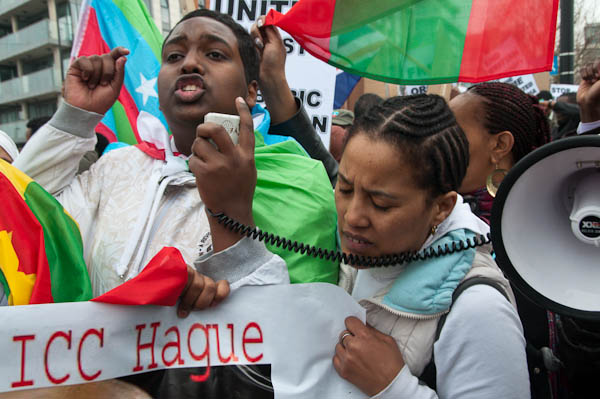
Demonstrators call for Ethiopian dictator to be tried for war crimes against
Somalis in Ogaden
more pictures
While the G20 were in session at London's Excel conference centre, the three
closest stations on the DLR were all closed, and everyone had to walk from
Canning Town Station. It wasn't a very long walk as we weren't allowed close
to the actual centre, but behind a double block of barriers guarded by a long
line of police on one of the entrance roads at the west end of the dock. It
wasn't even possible to see the Excel Centre - around half a mile away - from
there.
I'd expected a much larger protest, but perhaps too many were still recovering
from yesterday's baton thrashing by riot police in the City, or simply were
intimidated by it or the reports about it.
The largest and most vocal group there were Ethiopians protesting about the
killing and repression in Ogaden and Oromo. Ogaden was the
site of a conventional cold-war conflict between Somalia (backed by Russia
and Egypt) and Ethiopia (backed by the USA) in 1977-8. In April 1977, Russia
changed sides, supporting Ethiopia, and the USA then switched to support Somalia.
The war ended with a victory for Ethiopia and Somalia abandoned its attempt
to capture Ogaden, but a guerilla battle continued between Ethiopian troops
and the WSLF, (Western Somali Liberation Front) based in Ogaden.
In 2007, the Ethiopian Army began a major campaign in Ogaden against the
Ogaden National Liberation Front, a Somali group led by Mohamed Osman, killing
and torturing many Somali civilians and nomads living there - as documented
by Human Rights Watch.
Ogaden is important to Ethiopia because of the vast reserves of oil waiting
to be exploited there. The ONLF have attacked some oil exploration sites and
urged the international oil companies not to sign agreements with the Ethiopian
government.
The Oromo are the largest ethnic group in Ethiopia - about a third of the
population and mainly live in the centre and south of the country (and in
northern Kenya.) They are thought to be the oldest civilisation in the world
and have lived in the area since before the start of recorded history, the
first people to develop the use of tools and domesticate animals. In Ethiopia
they are split roughly equally between Christians and Muslims. The Oromo Liberation
Front, established in 1973, is one of several political and military Oromo
organisations, and aims to establish an independent Oromo state.
One of the banners on display was from the African People's Socialist Party,
founded in the USA in the 1970s and a part of the Uhuru movement, which "is
committed to the total liberation of Africa and African People everywhere."
The demonstration claimed that the Ethiopian regime is the most brutal in
the world and called for an end to British financial support for the Ethiopian
war on the people of Ogaden. They called for The demonstration claimed that
the Ethiopian regime is the most brutal in the world and called for an end
to British financial support for the Ethiopian war on the people of Ogaden.
They also want Ethiopian dictator Meles Zenawi to be tried by the International
Criminal Court for war crimes.
Other demonstrators included a number from CND and Stop The
War, as well as smaller groups including the International Bolshevik
Tendency and a guy protesting about the forgotten genocide in the DR
Congo which has killed 8 millions. But there were probably as many media people
than demonstrators - which resulted in the protests about Ogaden and Oromo
getting an unusual amount of media attention.
more pictures
Jobs not Bombs
US Embassy and Trafalgar Square, London. Wed 1 April, 2009
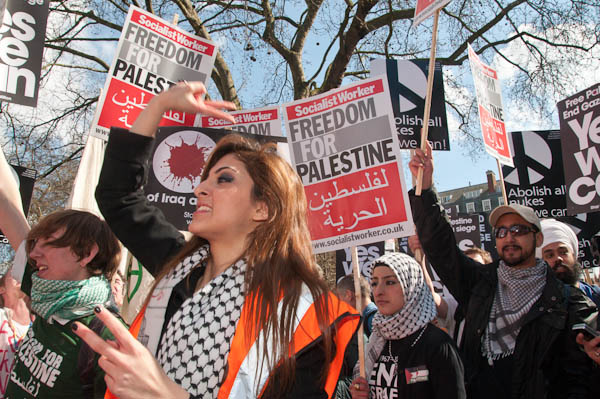 The
march gathered for a noisy protest at the US Embassy
The
march gathered for a noisy protest at the US Embassy
more pictures
Stop the War, along with CND, the Palestine Solidarity
Campaign and the British Muslim Initiative had decided to have
their own demonstration well away from the happenings in the City of London,
picking as their starting point the US Embassy. This made sense in that they
were demonstrating calling for an end to the wars in Afghanistan and Iraq,
and an end to the Israeli siege of Gaza, as well as an end to the senseless
spending on bombs, particularly on the Trident replacement.
There were perhaps a thousand or two for the start of the march at the US
Embassy, although more would have joined them from the Bank of England had
they not been penned in there. One of the few who did manage to get away and
attend the rally at Trafalgar Square, Ernest Rodker, was clearly horrified
and gave a graphic account of the violent police attacks on penned demonstrators
that were taking place there.
There were very few police around for this large official demonstration,
and they concentrated on traffic control to allow the march to pass through
the centre of London. Of course Stop the War are noted for their
tough stewarding - and at one point I had to grab hold of a steward as otherwise
I would have gone flying backwards as he and others changed direction and
pushed me over-firmly out of the way. It was an uncalled for assault, but
hardly unexpected.
Numbers had picked up a bit for the rally at Trafalgar Square, which was
reasonably full to hear the speakers, including Tony Benn - who got a chorus
of 'Happy Birthday' for his 84th on 3 April. Perhaps the only surprise for
me was the appearance of King Arthur, leader of the Socialist Labour Party.
Mr Scargill, a good friend of Benn, is only a spritely 71. The rally gave
a strong message of support to Dr Daud Abdullah, Deputy General Secretary
of the Muslim Council of Britain who is currently the subject of an unprecedented
attack by the British government, which has also severed relations with the
MCB. Other speakers included Lindsey German, Betty Hunter, Louise Christian,
Bruce Kent and Low Key, who spoke and rapped. As I left to go home, Julie
Felix was on stage and I was back in the sixties.
more pictures
G20: Climate Camp in the City
Bishopsgate, London. Wed April 1, 2009
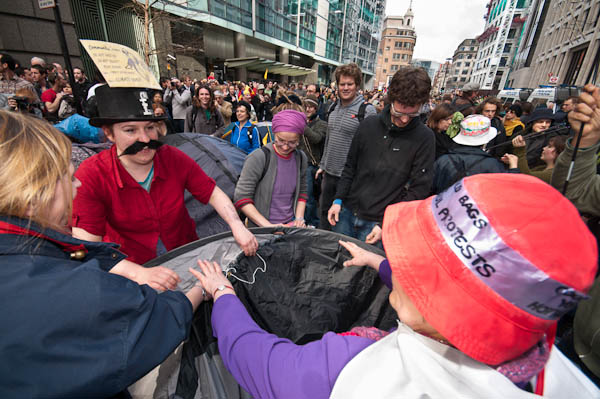
Setting up tents in the middle of Bishopsgate
more pictures
I arrived dead on 12.30 as the Climate Camp Mass cyclists came up the road and
people emerged out of corners to start to pitch tents on Bishopsgate. Soon there
was a real carnival atmosphere with dancing and music, and people were getting
down to picnicking on the street.
Although within the Climate Camp on Bishopsgate things seemed to be going
well with a very positive atmosphere - and it was good to find a few MPs who
had come along to see what was happening, at the edges things were starting
to break up. A line of police across the junction with Camomile Street and
Wormwood St were clearly looking for trouble. I was pushed back quite forcibly
when they wanted to clear the road for a bus to pass, when a simple polite
request would have been appropriate, and there was soon a line with police
confronting demonstrators.
There seemed to be no particular reason for this aggressive approach by the
police. Then some scuffles started when police grabbed hold of people wearing
face masks who had refused to remove them - again I could see no reason to
start trying to get people to unmask when there was no public disorder - it
seemed as if police just wanted to pick a fight with the protesters.
At this point I left to go and photograph the Stop the War demo starting
at the US Embassy. Later there were more reports and videos of police attacks
on these peaceful protesters, with riot police moving in and attacking people
who raised their hands in the air and chanted "this is not a riot."
Later police got even more out of hand, wantonly smashing property and people.
A number of those who tried to defend themselves were arrested. Watching the
videos and seeing the photos is sickening, and a terrible indictment of the
kind of police state we now live in. Only a few years ago we would have viewed
scenes like this from overseas and said (perhaps rather smugly) to ourselves
thank goodness we live in a democratic country where justice prevails. No
longer.
There was a report at 9.35 of a photographer being threatened the recently
enacted anti-terror legislation that prohibits photography of police, which
I think is the first time police have used this. This came despite earlier
police promises that the G20 demonstrations would be dealt with under public
order legislation and would not be another example of the inappropriate use
of anti-terror laws.
Late at night there were still around 2000 people inside a police 'kettle'
at the Climate Camp, with police attempting to force people out of the area
one or two at a time, demanding that people give their names and addresses.
more pictures
G20 Meltdown - Financial Fools Day
City of London, April 1, 2009

Capitalism isn't working - Another World is Possible
more pictures
A crowd of around 500 had gathered by 11am outside Cannon St station where the
Black Horse, one of four '
Horsefolk of the Apocalypse', against
land enclosures and borders (today was the 360th anniversary of the
Diggers
occupation of land at St Georges Hill in Surrey) was to start its march to the
Bank of England for the
G20 Meltdown 'Banquet at the Bank'.
By around 11.15, some of the anarchists present had got fed up with waiting
for the official start and decided to make a move, but were stopped by police.
Despite the protests of one of the G20Meltdown organisers they then surged
away down a side street in the opposite direction to the bank.
The police followed, but made no real attempt to stop them, and after some
fairly random wandering - none of those leading the marchers knew the way
- found someone with a map and made their way by a rather roundabout route
to the Bank.
I left them there and walked down towards London Bridge, to meet the Silver
Horse against financial crimes, which was accompanied by perhaps fifteen
hundred demonstrators in a rather more mixed and colourful procession, and
joined them to go back to Bank.
By now others were also arriving, and soon the whole open area between the
Mansion House, Bank and Royal Exchange was crowded with demonstrators, media
and police, but not a great deal seemed to be happening. There were a dozen
or so people watching from the roof of the bank, but its doors were firmly
closed. I tried to make my way down Threadneedle St, but a little way past
the doors of the Bank I gave up as the crush was too tight and returned to
Prince's Street.
Police by now had decided to stop people entering or leaving the area, at
least along Prince's Street, although there didn't seem to be any good reason
for this - there seemed to me to be absolutely no issues of public order or
safety - although there were crowds, people were just standing around, or
listening to the samba band or watching street theatre.
They had also asked TfL to close Bank Station, another over-reaction. Obviously
some of the exits actually at the Bank needed to be closed but some in neighbouring
streets could have been kept open as well as allowing interchange between
lines and exit via Monument. While I was around there seemed to be little
reason to close the exit in Poultry either - so little need to close the Waterloo
and City. This seemed to be a deliberate decision by the police to cause as
much disruption to the underground system and inconvenience to the travelling
public as possible.
Fortunately although the police had sealed off the area they were letting
press through, so I was able to leave and walk up Lothbury and Throgmorton
St, then across Old Broad St and through the alley into Bishopsgate.
Later in the day, long after I left, police charged the penned-in demonstrators.
Police horses were used as well as baton charges, and a man was killed.
more pictures
top of page
All pictures on this section of the site are Copyright ©
Peter Marshall 2009; to buy prints or for permission to reproduce pictures
or to comment on this site, or for any other questions, contact
me.
















 Dutch toffee waffles were on sale
Dutch toffee waffles were on sale 
















